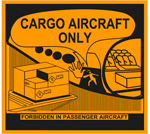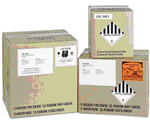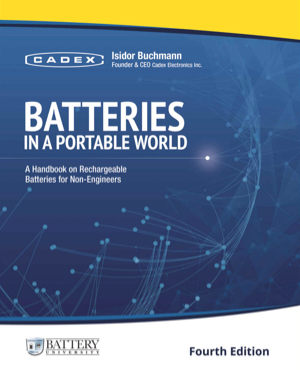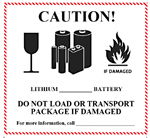Regulations made easy to Understand
Battery shipment has come under strict transportation regulation and this is especially critical with lithium-based products. The International Air Transport Association (IATA) and Dangerous Goods Regulation (DGR) are trusted resources to help prepare and document dangerous shipments. Recognized by the world’s airlines for over 50 years, the DGR Manual is the global reference for shipping dangerous goods by air. (See http://www.iata.org/publications/dgr/Pages/index.aspx)
Li-ion batteries have improved and the official failure rate has been reduced to one-in-10 million. Experts believe that this number is high as unplanned events are few and far in between. Examining 113 recorded incidents of transporting batteries by air in 19 years reveals that most failures occurred due to inappropriate packaging or handling. This resulted in battery damage that triggered an electrical short. Most events happened at airports or in cargo hubs and not on a carrier. Lead, nickel and alkaline-based systems are part of the problem, not just lithium-ion as is commonly perceived.
IATA published Dangerous Goods Regulations that provides guidelines in the shipment of lithium-based batteries on passenger and cargo aircraft. The quantity permitted is based on watt-hours (Wh). Wh establishes the lithium content by multiplying voltage with the ampere-hours (Ah). For example, multiplying 14.40V by 5Ah battery comes to 72Wh, a size that is common for a laptop battery.
The article also informs what a traveler can take as carry-on on an aircraft. Since January 2008, lithium-based batteries can no longer be checked in with the baggage but airlines allow them as carry-on. The passenger compartment has better safety monitoring and access to fire extinguishers, should an event occur. Non-removable batteries do not count as batteries. Out of sight, out of mind.
To protect against short circuit, IATA recommends placing battery packs into clear plastic bags. A battery pack must further be approved even if the cells in the pack had been approved. This provision also applies to modified battery packs.
The transport of lithium-based battery products is divided into non-Class 9 hazardous material and Class 9 hazardous material. Non-Class 9 allows the shipment of small batteries in limited quantities and Class 9 hazardous material involving the shipment of larger battery sizes and in higher volume.
The Packaging Instructions (PI) are organized into PI 965 to PI 970. PI 965 covers Li-ion cells and battery packs only, PI 966 includes Li-ion installed in equipment and PI 967 combines Li-ion with equipment. Lithium-metal batteries are categorized separately in PI 968 to 970.
Packaging Instruction 965 — includes loose Li-ion cells and battery packs (UN 3480)
Table 1 divides the transport of Li-ion products into four groups: Carry-on states the quantity of Li-ion cells and battery packs a passenger can take on an aircraft; Section 11 specifies shipment of small Li-ion products in low numbers; Section 1B advises on the shipment of small Li-ion products in larger numbers, and Section 1A governs larger Li-ion products. Only Carry-on and Section 11 are exempt from Class 9 hazardous material designation.
IATA mandates that cells and battery packs cannot be combined in the same shipping box and recommends separate boxes. If the boxes can be combined into one shipping box, the Overpack label must be attached (please see below).
Sections | Cell/battery size | Weight/Number Limitation | Note |
|---|---|---|---|
| Carry-on Passenger | Maximum battery size 100Wh | Each passenger can take 2 spares not exceeding 100Wh | Carry-on only. Not allowed in checked luggage |
| Section 11 Small size, low volume | Cell 20Wh1 or less → Battery 100Wh2 or less → Cells/batteries 2.7Wh → | 8 cells, no weigh limit 2 batteries, no weigh limit 2.5Kg, no number limit | Not subject to Class 9; can be shipped by courier and mail; must include Lithium Battery Handling Label and CAUTION label. |
Section 1B Small size, high volume | Cell less than 20Wh Packs less than 100Wh | 10kg for passenger aircraft, 10kg for cargo per package | Class 9, subject to all applicable requirements |
Section 1A Full load | Cells larger than 20Wh Packs larger than 100Wh | 5kg for passenger aircraft, 35kg for cargo per package | Class 9, subject to all applicable requirements |
Table 1: Packaging Instruction 965 covering Sections 11, 1B and 1A — Shipment of loose Li-ion cells and battery packs.
1 Typical smartphone or tablet battery; 2 Typical laptop battery
Non-Class 9 shipments relating to PI 965 mandate additional guidelines.
| Labels: | Each package must include the CAUTION label and the Lithium Battery Handling Label containing the words "Lithium ion batteries in compliance with Section 11 of PI 965” (or applicable PI number) as illustrated in Figures 2. Also add a contact phone number to cover unforeseen events. |
| Overpack: | Larger shipments than permitted under Section 11 can be divided into separate boxes and combined in a larger pack. Add Overpack label on the shipping box in addition to the other required labels. Keep the box under 30kg (66 lb). See label in Figure 3 |
| Damage: | Batteries identified as defective and in danger of failing in transport are forbidden. |
| Old batteries: | Lithium battery products for disposal are forbidden from air transport unless approved by the appropriate authorities. |
| Packing: | Each shipping package must withstand a 1.2 meter drop in any orientation without damaging the batteries, causing them to shift or releasing the contents |
Class 9 has these added regulations to the above mentioned requirements.
| Training: | Anyone handling lithium-based batteries for transport must be trained. Please see http://www.iata.org/training/courses/Pages/shipping-lithium-batteries-tcgp52.aspx |
| Approval: | All Li-ion batteries shipped under Class 9 hazardous material designation must meet the UN Manual of Test and Criteria, Part III, subsection 38.3. |
| Labels: | Class 9 packages must include [1] Class 9 hazard material label, [2] UN designation (UN 3400, 3481, 3090 or 3091), [3] marking “Lithium Battery” with packing information (PI 965, 1B, 1A or other), [4] name and address of the shipper and consignee, and [5] the number of packages and gross weight per package. Class 9 labels are illustrated in Figure 4. |
 |  |  |
Label dimension: 100mm x 100mm (3.94″ x 3.94″)
Figure 4: Class 9 Hazardous Material Label.
Packaging Instruction 966 — governs Li-ion cells and battery packs with equipment (UN 3481) and Packaging Instruction 967 — governs Li-ion cells and battery packs in equipment (UN3481)
These regulations are similar to PI 965 with the exceptions that Li-ion cells and battery packs can be shipped with, or in, the equipment. Equipment means an apparatus requiring Li-ion products to operate.
| Sections | Cell/battery size | Weight/Number Limitation | Note |
Section 11 | Cell 20Wh or less, packs 100Wh or less | 5kg for passenger aircraft, 5kg for cargo aircraft | Not subject to Class 9; can be shipped by courier and mail; must include Lithium Battery Handling Label and CAUTION label. |
Section 1 | Cells larger than 20Wh, packs larger than 100Wh | 5kg for passenger aircraft, 35kg for cargo aircraft | Class 9, subject to all applicable requirements |
Table 5: Packaging Instruction 966 and 967 — Shipment of Li-ion batteries with, and in equipment.
PI 966 and PI 967 have these additional requirements.
| Limitation: | The maximum number of batteries in each package must be limited to those required to operate the equipment. Extras must be shipped separately or in Overpack. |
| Activation: | Equipment must be turned OFF. Accidental activation in transport must be prevented. |
| Exceptions: | Devices such as watches and temperature loggers that do not pose a danger in transport may be left in the ON position. |
Packaging Instruction 968 — permits lithium-metal cells and battery packs (UN3090)
Lithium-metal batteries have tighter shipping requirements than lithium ion batteries. Most Li-metal cells or battery packs are non-rechargeable found in watches, medical instruments, pacemakers, sensors, memory retention and more.
Sections | Cell/battery size | Weight/Number Limitation | Note |
|---|---|---|---|
Section 11 Small size, low volume | Lithium-metal content → per unit 0.3g or less Lithium-metal content → in cells 1g or less Lithium-metal content → in battery 2g or less | 2.5kg weigh limit No limit in number 8 cells
| Not subject to Class 9; can be shipped by courier and mail; must include Lithium Battery Handling Label and CAUTION label. |
Section 1B Small size, high volume | Lithium-metal in cells 1g or less; battery 2g or less | 2.5kg for passenger aircraft, 2.5kg for cargo per package | Class 9, subject to all applicable requirements |
Section 1A Full load | Lithium-metal in cells exceeds 1g; pack 2g | 5kg for passenger aircraft, 35kg for cargo per package | Class 9, subject to all applicable requirements |
Table 6: Packaging Instruction 968 — Shipment of lithium metal cells and battery packs.
Effective 1 January 2015, lithium metal batteries will be restricted to cargo aircraft only. This only applies when shipping lithium metal batteries by themselves. Batteries packed with or contained in equipment can continue to be shipped on passenger aircraft.
Additional Requirements for lithium metal batteries as part of PI 968:
| Packaging: | Cells and battery packs must be packed in a rigid outer packaging. |
| Padding: | Batteries must be surrounded by non-conductive, non-combustible cushioning material. |
| Label: | When the package does not meet the above requirements, mark “Cargo Aircraft Only” as illustrated in figure 7. |
| Limitation: | Lithium-metal in any equipment must not exceed 12g/cell and 500g/battery. |
| Exceptions: | Button cell installed in equipment and circuit boards do not add to the battery count. |
 | Label dimension 300mm x 300mm (11.8” x 11.8”) Other dimensions may apply Because of size, label cannot be printed on a regular printer. |  |
Figure 7: Cargo Aircraft Only label; added to one shipping box with other mandated labels
Packaging Instruction 969 — includes lithium metal with equipment (UN 3091)
Packaging Instruction 970 — includes lithium metal in equipment (UN 3091)
| Sections | Cell/battery size | Weight/Number Limitation | Note |
Section 11 | Metal content in cells less than 1g; in battery packs less than 2g | 5kg for passenger aircraft, 5kg for cargo aircraft | Not subject to Class 9; can be shipped by courier and mail; must include Lithium Battery Handling Label and CAUTION label. |
Section 1 | Metal content exceed 1g in cells and 2g in packs | 5kg for passenger aircraft, 35kg for cargo aircraft | Class 9, subject to all applicable requirements |
Table 8: Packaging Instruction 966 and 967 — Shipment of lithium metal batteries with and in equipment.
The Internet provides excellent resources to assist in the shipment of dangerous goods. Simply google: “Shipping Li-ion batteries by air” and much help is offered. Also google “IATA training.”
Definition
International Air Transport Association is a private organization that promotes cooperation among the world's scheduled airlines to ensure safe, secure, reliable, and economical air services. IATA harmonizes with other agencies internationally.
About the Author
Isidor Buchmann is the founder and CEO of Cadex Electronics Inc. For three decades, Buchmann has studied the behavior of rechargeable batteries in practical, everyday applications, has written award-winning articles including the best-selling book “Batteries in a Portable World,” now in its third edition. Cadex specializes in the design and manufacturing of battery chargers, analyzers and monitoring devices. For more information on batteries, visit www.batteryuniversity.com; product information is on www.cadex.com.





The link for the battery shipping label is dead. It used to link to a printable label.